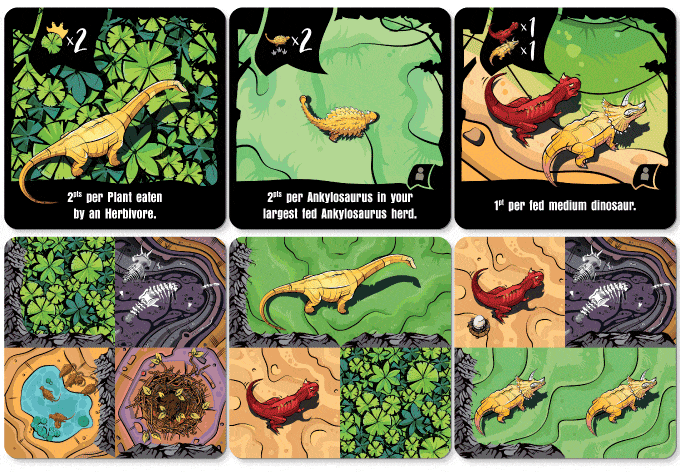Chomp
About:
Chomp, designed by Clarence Simpson and published by Allplay, is a 2-4 player small box game filled with big dino fun. As you build out a land for your dinos, you'll also be building a puzzle-y chain of dino feeding and unique scoring goals.
Each turn, you choose to take a point-scoring goal card or a card to grow your dino-inhabited land. Score points for feeding your dinosaurs and fulfilling your goal cards, but if carnivores can't feed on small animals at the watering holes, they'll chomp on your herbivores.

Project Overview:
For Chomp, our primary focus was expanding the game from the designer's initial 18 card microgame into a full sized production for Allplay with a higher playercount. The original 18 cards were exactly enough for two players to play at a time. The delivered prototype rules suggested that there could be a duplicate deck of 18 cards used for three and four player games, but early testing feedback indicated that having too many duplicate goal cards appear in a game wasn't satisfying for players.
So we set ourselves the goal of designing new goals to DOUBLE the amount of unique tile configurations and scoring goals in the game. After some initial exploration, we added new element to the game: eggs and nests. When you take a tile with an egg, if you already have an empty nest, you can place an egg token in that nest.
This creates a new little mini-game: if you don't have a nest, it changes the value of cards with eggs slightly lower, if you have one, it pushes them higher. And it gave new dimensions and icons for goal design: of the 18 new goals, 7 are related to eggs or nests.
Services Provided:
- Content Design
- Game Development
- Mathematical Analysis
Case Study: Monte Carlo Simulation

One particularly tricky part of the new addition: figuring out how many nests and eggs there should be. To do so, we needed to see what the expected value of pairs was for any given distribution of [Eggs] [Nests] [Cards with neither] in the deck.
The math for making pairs is fairly straightforward, but the tricky bit is in the restriction requiring the pairs to be in order: a set of cards [Nest][Nothing][Egg] contains 1 scoring pair, but [Nothing][Egg][Nest] contains no scoring pairs. We investigate different potential distributions using a technique called Monte Carlo Simulation. To start, you observe the data across many, many games. As the count grows toward infinity, the statistical results of those games begin to approach the expected values.

In Monte-Carlo simulation, we write a custom computer program to deal us a million games of Chomp every time we hit a button. Then, we can plug in different values of eggs, nests, and player counts to check the expected counts of pairings and other data. It's a powerful technique that we can use to help our clients solve tough balancing problems on a variety of game styles. Our analysis suggested that we needed a few more pairings for the mechanism to consistently pay off, so we increased our supply of these icons.
Game development isn't all math, but it's always intriguing when you get a problem that requires a fresh technique to solve. One of our favorite parts of development is that every game presents a new challenge, and even a small box game like Chomp can surprise you with hidden depths.
Brieger Creative Team
- John Brieger
- Michael Dunsmore
See more on the Chomp Kickstarter page.